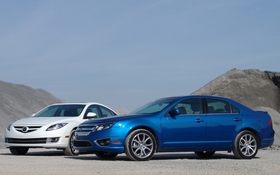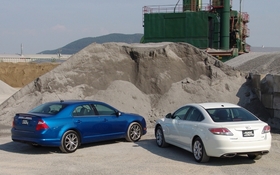2011 Ford Fusion vs. Mazda6: Twins, but not identical
Many people were surprised to learn that the first Ford Fusion was built on the same platform as the Mazda6. Yes, indeed. Ford was a major shareholder at Mazda, and the two companies had already joined forces on a number of different models. This also explains why Focuses were derived from the über-popular Mazda3. In fact, the new Focus is a modified version of the European Mazda3. But now that these two automakers are independent from one another, there’s a strong chance that any further collaboration will be cut from the agenda.
Although the Fusion and Mazda6 have the same platform, they’re hardly carbon copies of one another. For the first generation of the Fusion, the Dearborn-based engineers did major modifications to the Mazda6’s sport characteristics, making the suspension more forgiving while preserving its road handling capabilities. Since the 2006 launch of the Fusion, a lot of changes have been made. The Mazda6 has boosted its trunk size and is now the bigger and heavier of the two.
So much for the assumption that American cars are big and Japanese cars are small! But everything’s relative, and the size difference between these cars remains minor. The Mazda6’s wheelbase is 72 mm longer, and in total the Japanese vehicle is 114 mm longer than its American counterpart. In 2009, Mazda decided to increase the size of its intermediate sedan to rival the Toyota Camry and Honda Accord. Thankfully, these changes didn’t negatively impact its appearance or road handling. But how can you compare two models that, despite having a few things in common, are still markedly different from one another?
There’s no accounting for personal taste
It’s hard to be impartial when comparing the exterior and interior styles of these cars. The stylists who designed the Fusion went for a family-friendly appeal. After all, in the Ford hierarchy, this is a family car with no claim to sport capabilities. It features the traditional three-bar Ford grille and a relatively conservative rear section. The only bit of personality that really shines through is in the triangular lights.
With the Mazda6, it’s another story altogether. The Hiroshima designers focused on giving this vehicle a truly sporty look – the “Zoom Zoom” look that all Mazdas are known for. The front end plunges downward and the front grille is much more dynamic than Ford’s. In the rear, the roofline is much more aggressive, making it look like a hatchback.
Because of its more sassy appearance, the Mazda6’s rear seats are harder to access. The plunging roof forces you to bend lower to make your way in. But once you’re behind the wheel, you’ll note that, overall, the presentation is much less austere than in the Fusion. The aluminum accents on the spokes of the steering wheel, the two black dials traced in white and aluminum-framed console all stand out for excellent effect.
This is not to say that the Ford’s interior is not attractive; it’s just more discreet. It follows almost all the same recipes used by Mazda, but with less pizzazz. Sure, there are LED dials, but there’s a lot more grey plastic inside the Fusion. But when it comes to the quality of assembly and materials, the two vehicles tie: 0-0.
Since both are built for families, a good look at the trunk space is in order. Once again, it’s a tie game, with the Fusion at 467 litres and the Mazda6 at 469 litres.
Diversity and consistency
When comparing the engines, the Fusion wins, no contest. At least as far as diversity is concerned. This sedan can be ordered with a hybrid engine, a 2.5-litre four-cylinder engine, a 3.0-litre V6 or a 3.5-litreV6. In contrast, selection is more limited for the Mazda6. First there’s the 2.5-litre V6 – it’s the same one available in the Fusion, as the two companies had an agreement under which Mazda developed four-cylinder engines for Ford. Alternatively, you can equip the Mazda6 with a 3.7-litre V6, which is built by Ford!
For the sake of this comparison, we stuck with the 2.5-litre engine. At Mazda, you can pair it with either a six-speed manual transmission or a five-speed automatic. It offers 170 horsepower. In the Ford, the same engine produces an extra five horsepower and can be combined with a six-speed manual or automatic. In theory, the Fusion has a slight advantage in terms of power and its automatic gearbox is a little better. However, the Mazda has a faster -100 km/h time. The Ford comes out ahead by a few tenths of a second in the 80-120 km/h race. When it comes to braking, the Mazda6 needs 3.7 metres to come to a stop from 100 km/h. And as for fuel consumption, the Fusion claims to drink 1 litre less for every 100 km.
In terms of performance, these two are practically neck-in-neck, with the Ford have a slight advantage in fuel consumption. However, this really depends on your driving style. With this variable in mind, we’re forced to declare another tie game. So how do the Mazda6 and Ford Fusion compare on the road?
Make room for Zoom Zoom!
For our road test, we stuck to 2.5-litre four-cylinder engines since it was hard to find equivalents for the other options. We also went for the automatic transmission, even though Mazda’s featured one gear less than Ford’s. In the end, the two gearboxes were similar in terms of speed, reaction time and smoothness. Nonetheless, I’ve got to say that Mazda’s manual gearbox is always a pleasure.
In the Fusion, the transmission is irreproachable. Shifting is smooth and the sixth gear translates into improved fuel consumption (which explains the difference between the two cars). But if you’re looking for driving pleasure, Mazda has the upper hand. Oddly enough, the version with the four-cylinder engine is the most impressive to drive, as it is more responsive and hugs the road better. You’re sure to be impressed by the GT version with a four-cylinder engine.
I’d like to add that the Mazda6’s steering is more precise, the suspension is sportier and a bit more rigid than most other vehicles in its category. If you prefer a more bourgeois vehicle that nonetheless hugs the road superbly, you’ll like the Ford Fusion. This car feels like a much bigger, more luxurious and more expensive sedan than what it really is. Meanwhile, none of these things will cross your mind when you drive the Mazda6, but that’s just because you’ll be busy having fun at the wheel.
At the end of the day – a day of comparison driving, that is – the verdict is simple: if you want comfort, good soundproofing and a forgiving suspension, choose the Ford Fusion. The hybrid version of this model is even more exceptional, coming in at the top of its class. However, drivers who appreciate a responsive vehicle with better road handling and a more dynamic style are better off with the sporty Mazda6.












